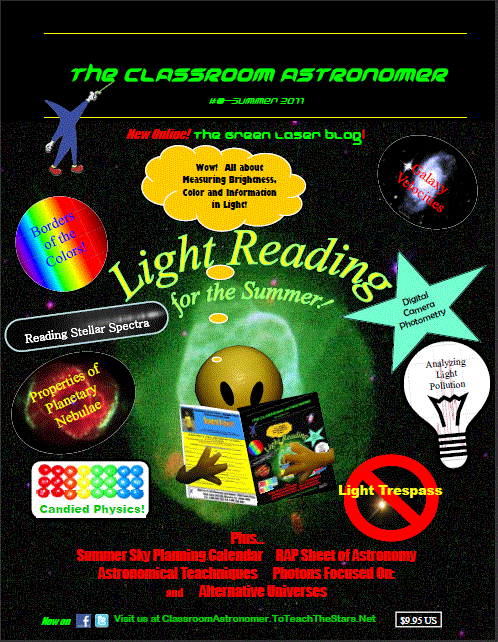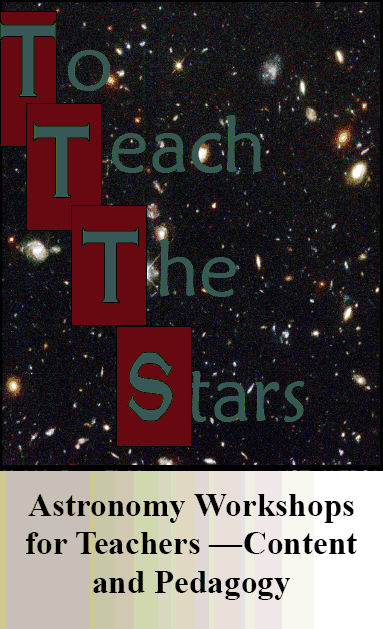THE STATUS AND MAKEUP OF THE
U.S. HIGH SCHOOL ASTRONOMY COURSE IN
THE ERA OF NO CHILD LEFT BEHIND
by
DR. LAWRENCE E. KRUMENAKER
Copyright 2008-9 by the author.
Dissertation defended on
February 7, 2008, in the Department of
Mathematics and Science Education, University of Georgia, Athens,
Georgia
This
page is dedicated to the hundreds of teachers who responded
in 2007 (and principals, in 2008) to email and mailing list pleas for
assistance. Without these replies no dissertation or subsequent
articles would have been possible. You have my utmost gratitude and
respect for the hard work you do in high schools (I know, I taught
there too!)
Please note that as of May 10, 2008, I was no longer officially at the
University of Georgia.
Linked to this page are some summaries but as the research got
published, the articles have become the materials available here.
Dr. Larry Krumenaker
Dissertation Abstract
A spring 2007 nationwide survey of high school astronomy teachers
investigated: how many high schools teach astronomy, teacher
backgrounds, student demographics, classroom materials and facilities
and other facets of the modern course. Comparisons were made to Philip
Sadler’s 1986 survey and to various states’
Departments of
Education data. This multimethods study included qualitative questions
investigating teachers’ perceptions about effects from
2001’s No Child Left Behind Act (NCLB) on their classes,
views of
course futures in their schools, and the nation. Other questions
solicited their community wisdom on starting a course, defending it,
and what needs to be done to increase their number.
Significant conclusions
include: the number of regular classes are
about 3200, totaling up to 4000 when a ‘hidden’
single-digit-sized classes population is added in; fully 20% of all
classes may be with 10 or fewer students. A course is found in 2500
schools, 12-13% of all U.S. high schools.
Many of Sadler’s
numbers are unchanged in 22 years. However,
the ratio of male to female teachers has gone from 88:12 to 67:33. Many
teachers now come from the bioscience and geoscience majors, not
physics. We tally 3-4% more schools now than Sadler, and nearly twice
the teachers (3200).
Schools with astronomy are more
often Passing in Adequate Yearly
Progress (AYP) than the national norm. Classes generally reflect
racial, gender and ethnic demographics of their schools and the nation.
More than half of all teachers
claim no direct effects from NCLB on
their courses, most of the rest seeing negative effects, generally
dependent on how other science, math and language courses fare.
A growing number supplant
conventional planetariums with computer
"planetarium" software, currently at the same rate as portables
ownership.
Twenty-eight percent of
teachers are not ‘highly
qualified’ in that they have never had an astronomy course,
let
alone an astronomy degree.
Teachers are generally more
optimistic than pessimistic but their
optimism is mostly for their school, not for the fate of courses around
the nation.
A six-part plan for starting a
class is developed and six defensive
arguments are also offered.
|
A short, five page
summary can be found here.
|
|
Published
article The
Modern U.S. High School
Astronomy Course, its Status
and Makeup, and the Effects of No Child Left Behind,
December 2009, Astronomy
Education
Review based
on the 260 response "Spring Survey" of teachers via email/Web.
That file is here.
|
| A second survey went out
in the Fall of 2007 via postal
rather than electronic means. That research was published in the same
issue of Astronomy Education
Review in December
2009 as The
Modern U.S. High School Astronomy
Course, Its Status and Makeup
II: Additional Results. That
file is here. |
These are from a
talk given at NSTA Boston in March 2008.
- How to start a high school
course of astronomy, click here.
- How to defend an existing
high school course when
threatened by NCLB or other influences, click here.
A list of resources that
teachers use to keep up with astronomy,
astronomy education pedagogy,
and the community of astronomy
educators
(the subject of a January 2008 AAPT presentation) can be found
at here.
|
|
A
last, third
survey went out in the Spring of 2008 to principals (or other
schedule
deciders) at schools without
astronomy. An article based
on this survey has been published by Astronomy Education
Review (Vol 9,
#1, 2010) and went online January 2010 entitled as What It Would Take to
Increase the Number
of High School
Astronomy Courses: A Survey of Principals and a Comparison to
Astronomy Teachers, and
a
Prescription
for Change.
That last part is a
summary of all three surveys' results molded into a procedure
that
can be used to increase the number of astronomy courses in American
high schools. It can be downloaded here.
|
An
article
based upon this research specifically on schools with planetariums
appeared in the December 2008 issue of the journal The
Planetarian:
Journal of the International Planetarium Society.
That
article, High Schools with
Planetariums: Results of a Survey is
not available online but can be downloaded here.
An article on No Child Left Behind's effects on high school astronomy
courses appeared in The
Science Educator, Fall 2009
issue.
It can be read here.
|
Three tangible
benefits directly spinning off of these results...
The Magazine for Astronomy Teachers

|

Click the above to find
out where the next of our workshops will take place, or invite us to
your school!
|
|
For further information or to offer speaking engagements,
contact Dr. Lawrence Krumenaker via email larryk {at}
toteachthestars.net.
Return to Hermograph Press
| Return to To Teach
The Stars Home Page


